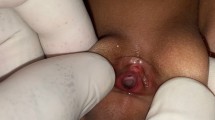Abstract
Aim
We assessed continence after scope-assisted anorectovaginoplasty (SARVP) for female anorectal malformation (FARM).
Methods
Five FARM cases were assessed; cases 1 and 2: cloacal malformation; case 3: urogenital sinus, and rectovestibular fistula (RF); case 4: RF, absent vagina, and sacral anomaly; case 5: covered cloacal exstrophy. Treatment was SARVP in all cases, with perineal vaginoplasty (case 1), vagina pull-through (PT) similar to Georgeson’s colon PT (case 2), and the use of the native RF/cloaca channel as a vagina (cases 3–5). Continence was assessed pre and postoperatively.
Results
SARVP was performed in the lithotomy position without repositioning. Mean age at surgery was 3.2 (1.7–5.5) years. Current mean age: 8.8 years (range 7.5–12.2). Mean follow-up: 5.7 years. Preoperative continence: fecal: all had stomas; urinary: cases 1 and 2: continent; cases 3–5: incontinent. Postoperative continence: fecal: cases 1–3: continent; case 4: incontinent; case 5: awaiting stoma closure; urinary: cases 1 and 2: continent; cases 3 and 4: incontinent; case 5: continent (intermittent catheterization). Fetal continence evaluation questionnaire (CEQ) scores for cases 1–4 were 7.5, 9, 10, and 2 (maximum score 10, mean 7.1).
Conclusion
Scope assistance improves visualization, thus pelvic sphincter dissection/division is minimized with less detrimental impact on postoperative continence.


Similar content being viewed by others
References
Georgeson KE, Inge TH, Albanese CT (2000) Laparoscopically assisted anorectal pull-through for high imperforate anus—a new technique. J Pediatr Surg 35:927–930
Tei E, Yamataka A, Segawa O, Kobayashi H, Lane GJ, Tobayama S, Kameoka S, Miyano T (2003) Laparoscopically assisted anorectovaginoplasty for selected types of female anorectal malformations. J Pediatr Surg 38:1770–1774
Yamataka A, Segawa O, Yoshida R, Kobayashi H, Kameoka S, Miyano T (2001) Laparoscopic muscle electrostimulation during laparoscopy-assisted anorectal pull-through for high imperforate anus. J Pediatr Surg 36:1659–1661
Ichijo C, Kaneyama K, Hayashi Y, Koga H, Okazaki T, Lane GJ, Kurosaki Y, Yamataka A (2008) Midterm postoperative clinicoradiologic analysis of surgery for high/intermediate-type imperforate anus: prospective comparative study between laparoscopy-assisted and posterior sagittal anorectoplasty. J Pediatr Surg 43:158–162
Watayo H, Kaneyama K, Ichijo C, Hayashi Y, Lane GJ, Yamataka A (2008) Is intraoperative anal endosonography necessary during laparoscopy-assisted anorectoplasty for high/intermediate type imperforate anus? J Laparoendosc Adv Surg Tech A 18:123–126
Oshita M, Okazaki T, Lee KD, Lane GJ, Yamataka A (2007) Complete covered cloacal exstrophy. Pediatr Surg Int 23:1029–1031
Tong Q, Tang S, Pu J, Mao Y, Wang Y, Li S, Cao Q, Ruan Q (2011) Laparoscopically assisted anorectal pull-through for high imperforate anus in infants: intermediate results. J Pediatr Surg 46:1578–1586
Kudou S, Iwanaka T, Kawashima H, Uchida H, Nishi A, Yotsumoto K, Kaneko M (2005) Midterm follow-up study of high-type imperforate anus after laparoscopically assisted anorectoplasty. J Pediatr Surg 40:1923–1926
Busacca M, Perino A, Venezia R (1996) Laparoscopic-ultrasonographic combined technique for the creation of neovagina in Mayer-Rokitansky-Kuster-Hauser syndrome. Techniques and Instrumentation 66:1039–1041
Pena A, Hong A (2000) Advances in the management of anorectal malformations. Am J Surg 180:370–376
Levitt MA, Pena A (2010) Cloacal malformations: lessons learned from 490 cases. Semin Pediatr Surg 19:128–138
Peña A, Levitt MA, Hong A, Midulla P (2004) Surgical management of cloacal malformations: a review of 339 patients. J Pediatr Surg 39:470–479
Acknowledgments
This study was supported in part by a Grant-in-Aide (S0991013) from the Ministry of Education, Culture, Sport, Science, and Technology, Japan (MEXT) through the Foundation for Strategic Research Projects in Private Universities.
Author information
Authors and Affiliations
Corresponding author
Rights and permissions
About this article
Cite this article
Yamataka, A., Goto, S., Kato, Y. et al. Fecal and urinary continence after scope-assisted anorectovaginoplasty for female anorectal malformation. Pediatr Surg Int 28, 907–912 (2012). https://doi.org/10.1007/s00383-012-3141-3
Published:
Issue Date:
DOI: https://doi.org/10.1007/s00383-012-3141-3




